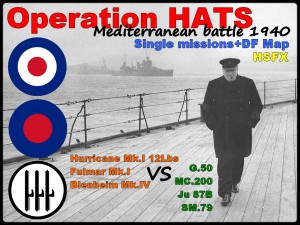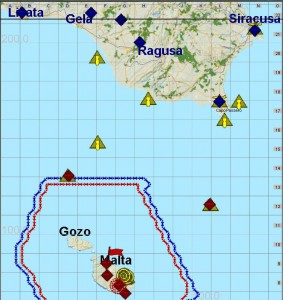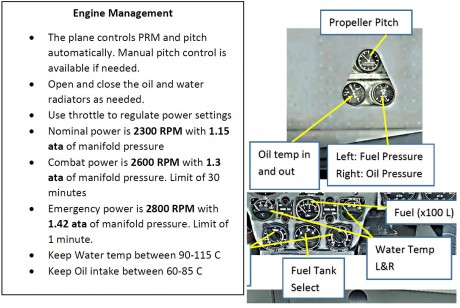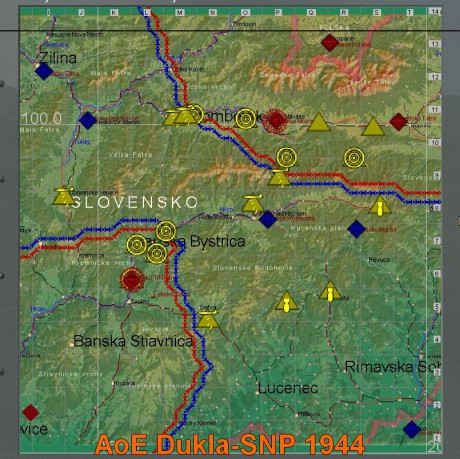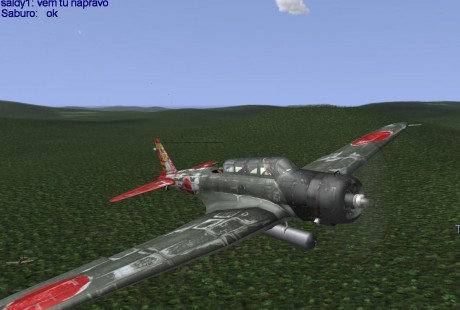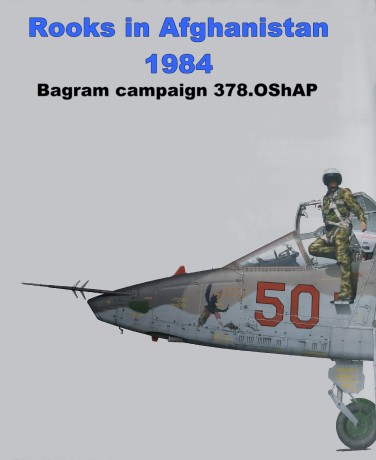Operation HATS 1940
DOWNLOAD
http://www.mission4today.com/index.php?name=Downloads3&file=details&id=1875
DF Map
Operation Hats (30 August-5 September 1940) was one of a series of complex operations carried out by the Royal Navy after the entry of Italy into the Second World War effectively split the British Mediterranean fleet in two. Operation Hats had several objectives. First, Admiral Andrew Cunningham’s fleet in the eastern Mediterranean was to be reinforced by the new carrier Illustrious, the modernised battleship Valiant and the anti-aircraft cruisers Coventry and Calcutta. Second, supplies were to be run to Malta. Third, both Force H and the Mediterranean fleet were to attack a variety of Italian targets in passing, amongst them Cagliari and Rhodes. Churchill had also hoped to take this chance to move a number of infantry tanks to Egypt, but this idea was strongly opposed by all relevant naval authorities and gained no support from General Wavell in Egypt, and as a result was abandoned (later in the year merchant ships were safely passed through the Mediterranean as part of Operation Collar, suggesting that the Admiralty had dramatically overestimated the danger from Italian air power, just as they had dramatically underestimated it before the war). The operation began on 30 August, when Somerville left Gibraltar and Cunningham left Alexandria
Somerville left Gibraltar at the head of the largest British fleet to enter the Mediterranean since the start of the war. Force H provided the carrier Ark Royal, the battlecruiser Renown the cruiser Sheffield, and seven destroyers, supported by the four modern ships heading for Alexandria and by another ten destroyers from Gibraltar. The first contact with the enemy came on 31 August, when Skuas from the Ark Royal destroyed two Italian floatplanes. At 21.50 on 31 August the destroyers Velox and Wishart were sent off to the north east in an attempt to convince the Italians that Somerville was heading for Genoa (Operation Squawk). The main fleet then turned to the south east, heading towards Cagliari. At 03.25 on 1 September nine Swordfish flew off the Ark Royal from a position 115 miles from Cagliari. The attack went in at 06.00 and the Swordfish had returned to the carrier by 08.00. Somerville then made a second change of direction, this time to the south west in an attempt to convince the Italians he was heading back to Gibraltar. This deception measure apparently had no effect, as the Italians were not then shadowing the fleet.
At 10.30 Somerville turned back onto his eastward course, heading for the Sicilian Narrows. At 22.00 on 1 September, half way between the south-eastern tip of Sardinia and the western tip of Sicily the force split in two. Force H turned to the north, in preparation for a second attack on Cagliari (made early on 2 September, this attack was foiled by haze and low cloud), while Cunningham’s reinforcements (now Force F), continued on to the south east, heading for Malta and the Mediterranean Fleet. Somerville’s force returned safely to Gibraltar early on 3 September.
Cunningham left Alexandria with the battleships Warspite and Malaya, the carrier Eagle, the cruisers Sydney and Orion and nine destroyers. This fleet was sighted at 14.30 by an Italian Cant Z 510, which was soon shot down, but a second aircraft was later heard overhead and escaped intact.
On 31 August, when off the southern coast of Greece, Cunningham was joined by Admiral Tovey and the 3rd Cruiser Squadron (Kent, Gloucester and Liverpool). On the same day, a convoy of three merchant ships with a destroyer escort, heading for Malta, was attacked by Italian aircraft and one of the merchant ships became the only British ship to suffer serious damage during the operations (although the ship successfully reached Malta). At roughly the same time one of the Eagle’s aircraft discovered an Italian battle fleet, consisting of two battleships and seven cruisers, 180 miles from Cunningham’s current position. Cunningham’s natural instinct was to head for the Italian fleet in the hope of provoking a battle, but on the next day the Italian ships were sighted heading for Taranto and home.
At 08.00 on 2 September Cunningham’s fleet sighted the Valiant, and the two halves of the operation finally came together. Valiant, Coventry and Calcutta were all carrying supplies for Malta, and so while the main Mediterranean fleet waited 35 miles south of Malta those three ships sailed into the Grand Harbour. Amongst the supplies they were carrying were eight 3.7in anti-aircraft guns, predictors and height finders to support the AA guns, replacement gun barrels, 10,000 rounds of Bofors ammunition, 100 Bren guns, and the post. Two air raids hit Malta while the ships were unloading, but by 19.00 the three warships were able to leave Malta.
Rather than return directly to Egypt, Cunningham decided to attack the Italian airfields on Rhodes. At this date the Aegean was still relatively safe for British ships, and so the fleet was able to sail north of Crete, collecting a convoy on the way. Early on 4 September Swordfish from the Illustrious, acting as dive bombers, attacked the Italian airfields at Maritiza and Callato, while HMAS Sydney bombarded Scarpanto. The operation finally ended on 5 September when the Mediterranean Fleet reached Alexandria. Operation Hats was one of a number of occasions during 1940 when the presence of a British aircraft carrier convinced a potentially strong Italian fleet not to risk combat, and played a part in reducing the effectiveness of the otherwise powerful Italian fleet.
(Source http://www.historyofwar.org)
Briefing
RA
-Destroy the ships and anded unloading supplies in the port of Valletta (G8)
-Find and sink the aircraft carrier HMS Illustrious (D14) and HMS Eagle (K12)
-Defend our shores and harbors.
RAF
-Defend the airspace above the port of Valletta (G8)
-Attack boat traffic on the coast of Sicily (F20, H18, M17)
-Find and sink-Italian submarines prowling in the area (F15, L16)
-Sink Ships parked in the port city of Siracusa (N21)
-In other ports may also be located Ships
-Attack and possibly block the importance RA airport (L17)
Missions
Hurricane
Your task is defend the port of Valletta (G8). From northwest at altitude 3,000 meters approaching bombers.
Fulmar
From the north at low altitude approaching torpedo bombers, quickly in the air!
From the south support us one Hurricans squadron from Malta.
(You must start from catapult)
Blenheim
You attack at dusk to the enemy airport (L17)
Stuka
Today, for the first time try our new weapon in combat that came from a German ally. Reaches a height of 3,000 meters and attack on enemy ships. Follow leader squadron.
SM.79
Attack and sink aircraft carrier, follow leader squadron. Fly with prop.pitch on 50%.
G.50 or MC 200
Protect our bombers, Sparvieros start from a the airport (H21) and flying to the southwest.
Into attack flies three torpedo squadrons. SM.79 Squadrons are distant from each 1 km. Your squadron will defend leader squadron (first torpedo squadron in order)
------------------------------------------------------------------------------------------------------------------------
Historická mise bude hratelná za výše zmíněné letouny, cílem bude potopit či ubránit HMS Ilustrious.
Hurrik
Vaším úkolem je ubránit přístav Valletta (G8), ze severozápadu letí bombardovací svaz ve výšce 3000m.
Fulmar
Od severu se v malé výšce blíží svaz bombardérů, rychle do zduchu!
Stuka
Dnes poprvé bojově vyzkoušíme naší novou zbraň dodanou od německého spojence. Dosáhnete výšky 3000m a zaútočíte na bojový svaz nepřítele.
SM.79
Zaútočte na bojový svaz a potopte letadlovou loď. Následuj vedoucí letku. (leť s náběhem vrtule na 50%)
G.50 nebo MC 200
Chraňte naše bombardéry, startují z letiště (H21) a letí na jih.
